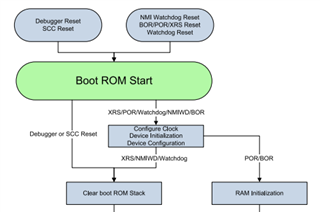I'm having a weird issue with CAN 0 on the F280025 (80 pin if it makes a difference).
If the processor is powered up normally (ie. 3.3V applied). It seems to send CAN messages just fine, but cannot receive anything. If I reset the processor (pulling XRSn low) then it works (or if I hold XRSn low during startup). Everything else seems to work just fine (boots properly from flash, pwms work, adcs function, etc..). When running off a debugger, I never have the issue (I would guess because it toggles the XRSn).
I'm using all the recommended practices for XRSn and 3.3 comes up very fast and is super stable.
I can properly detect that I'm not receiving and trying to re-init the CAN0 and it doesn't help. Only pulling XRSn low works. I've also tried using the simulated XRSn to reset the processor on startup... that didn't work either...
I haven't had this issue on F280049 or other C2000 processors. Any thoughts on how to fix this?


